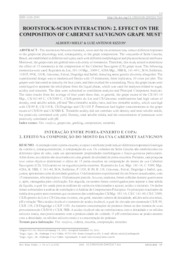Rootstock-scion interaction: 2.effect on the composition of cabernet sauvignon grape must.
Rootstock-scion interaction: 2.effect on the composition of cabernet sauvignon grape must.
Author(s): MIELE, A.; RIZZON, L. A.
Summary: The interaction between rootstock, scion and the environment may induce different responses to the grapevine physiology and, consequently, to the grape composition. The vineyards of Serra Gaúcha, Brazil, are established in different soil types, each with different morphological and physicochemical attributes. Moreover, the grapevines are grafted onto a diversity of rootstocks. Therefore, this study aimed to determine the effect of 15 rootstocks in the composition of the Cabernet Sauvignon (CS) grape must. The following rootstocks were used: Rupestris du Lot, 101-14 Mgt., 3309 C, 420A Mgt., 5BB K, 161-49 C, SO4, Solferino, 1103 P, 99 R, 110 R, Gravesac, Fercal, Dogridge and Isabel, featuring some genetic diversity altogether. The experimental design was in randomized blocks with 15 treatments, three replicates, 10 vines per plot. The grapes were harvested at maturity for four years, and then crushed for winemaking. Next, the grape musts were centrifuged to separate the solid phase from the liquid phase, which was used for analyses related to sugar, acidity and minerals. The data were submitted to correlation analysis and Principal Component Analysis. The main results from the average of four years show that, in general, the grape musts of the CS/101-14 Mgt., CS/161-49 C, CS/3309 C, CS/Rupestris du Lot and CS/Gravesac combinations had high values of density, total soluble solids, pH and °Brix/titratable acidity ratio, and low titratable acidity, which was high with CS/99 R, CS/110 R, CS/Dogridge and CS/1103 P. Potassium had higher concentrations in the grape musts of CS/SO4 and CS/5BB K. Titratable acidity did not correlate with density and total soluble solids, but positively correlated with yield. Density, total soluble solids, and the concentration of potassium were positively correlated with pH. Index terms: Vitis vinifera, grapevine, grafting, composition, minerals.
Publication year: 2017
Types of publication: Journal article
Unit: Embrapa Grape & Wine
Observation
Some of Embrapa's publications are published as ePub files. To read them, use or download one of the following free software options to your computer or mobile device. Android: Google Play Books; IOS: iBooks; Windows and Linux: Calibre.
Access other publications
Access the Agricultural Research Database (BDPA) to consult Embrapa's full library collection and records.
Visit Embrapa Bookstore to purchase books and other publications sold by Embrapa.

